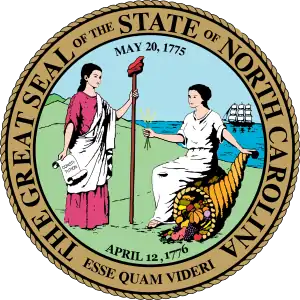Benjamin Smith (North Carolina politician)
Benjamin Smith (January 10, 1756 – January 26, 1826) was the 16th Governor of the U.S. state of North Carolina from 1810 to 1811.
Benjamin Smith | |
|---|---|
 | |
| 16th Governor of North Carolina | |
| In office December 1, 1810 – December 11, 1811 | |
| Preceded by | David Stone |
| Succeeded by | William Hawkins |
| Member of the North Carolina House of Commons | |
| In office 1789–1792 1804–1805 | |
| Member of the North Carolina Senate | |
| In office 1792–1800 | |
| Personal details | |
| Born | January 10, 1756 Charles Town, Province of South Carolina, British America |
| Died | January 26, 1826 (aged 70) Smithville, North Carolina, U.S |
| Nationality | American |
| Political party | Democratic-Republican |
| Spouse(s) | Sarah Dry |
Biography
Smith was born in Charles Town in the Province of South Carolina into a socially prominent family, later moving to Brunswick County, North Carolina. His parents were Thomas Smith and Sarah Moore Smith.[1] During the American Revolutionary War, Smith served an aide-de-camp to General George Washington and rose to the rank of colonel in the Continental Army.
In 1784, Smith was elected to the Continental Congress, although it is unclear whether he actually served. He was active in the North Carolina Constitutional Conventions of 1788 and 1789, and served a number of terms in the North Carolina General Assembly, in 1783 (Senate), 1789–1792 (House of Commons), 1792–1800 (Senate), 1801 (House of Commons) 1804–1805 (House of Commons) and 1806–1810 (Senate). From 1795 to 1799, Smith was the Speaker of the North Carolina Senate.[2]
During his political career, Smith also sat on the Board of Trustees of the University of North Carolina at Chapel Hill and donated 20,000 acres (81 km²) of land for the university's endowment; he chaired the trustees during his term as governor.
As of 1789, he owned 221 slaves.[3]
In 1810, aligned with the Democratic-Republican Party (he had earlier had Federalist leanings), Smith was elected governor by the North Carolina General Assembly. He served only a single one-year term, and emphasized reform of the state's criminal code and penitentiary system. Although Smith did seek re-election to the governor's seat in 1811, he polled behind William Hawkins on the first ballot and withdrew himself from consideration. He later returned to the North Carolina Senate in 1816.
Smith died in Smithville, North Carolina in 1826 and is buried at the St. Philip's Church near Wilmington. Smithville, now known as Southport, is situated a few miles outside of Wilmington along the Cape Fear River.
References
- Alan D. Watson, General Benjamin Smith: A Biography of the North Carolina Governor, p. 5, McFarland, 2014, ISBN 9780786485284
- Lewis, J.D. "Members of the North Carolina General Assemblies 1777-1800". Carolana.com. Retrieved November 13, 2019.
- https://museum.unc.edu/exhibits/show/slavery/benjamin-smith--1756-1826-
- Biographical Directory of the Governors of the United States, 1789–1978, Robert Sobel and John Raimo, eds. Westport, CT: Meckler Books, 1978. (ISBN 0-930466-00-4)
- National Governors Association
| Political offices | ||
|---|---|---|
| Preceded by William Lenoir |
Speaker of the North Carolina Senate 1795–1799 |
Succeeded by Joseph Riddick |
| Preceded by David Stone |
Governor of North Carolina 1810–1811 |
Succeeded by William Hawkins |
